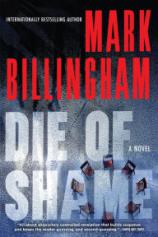Die of Shame
Review
Die of Shame
DIE OF SHAME is a bit of a different book for Mark Billingham. It is not entirely divorced from his popular Inspector Tom Thorne series, so that those familiar with that universe will enjoy seeing a recognizable character or two bounce in and out of the story. But it is one of his rare stand-alone efforts, and one in which he tinkers a bit with the classical narrative of the novel while presenting his readers with a work that is nearly impossible to put down.
The book jumps from its “now” to its “then,” and back again repeatedly throughout the narrative. Additionally, there is an occasional interlude featuring a conversation between a prison inmate who is close to being released from incarceration and a mysterious repeat visitor. These seem to have nothing to do with the story at hand. Veteran mystery readers know better, of course, but it is still a puzzling element in a book full of them.
"DIE OF SHAME is a homage to [Agatha] Christie, but the tale in the end is pure Billingham, full to the brim with grim humor and starkly defined characters whom you will love or hate but nonetheless will remember."
The novel’s “then” concerns a small group of addicts of various sorts --- substance abuse, gambling, sex --- who meet on a weekly basis with a well-known therapist who himself is somewhat troubled in a way that is gradually revealed throughout the course of the book. In the “now,” one of the members of the group is found murdered in his home, some two weeks post mortem. While the state of the body plays havoc with forensics, suspicion almost immediately homes in on the therapy group and its leader.
Detective Inspector Nicola Tanner is in charge of the investigation, and as she begins questioning the remaining members of the group, she starts running into a wall, that being the confidentiality that binds them with respect to the matters discussed in their weekly meetings and, more informally, their pub gathering afterward. Tanner is nothing if not quietly but effectively tenacious; if she can’t get at the center, she is resolved to peck and pull at the threads on the edges. Billingham gives the reader much more than he gives Tanner, though he parcels it out carefully, so that one is kept guessing until all is ultimately revealed. It is classic sleight of hand by a master of the genre.
Amateur sleuths among the reading audience of DIE OF SHAME will have a wonderfully frustrating time attempting to discern whodunit, and why, as their suspicions ebb and flow from one character to the next. And here we arrive at the heart of the book: Though it is a police procedural, it is first and foremost a classic mystery tale. Those who think of Agatha Christie as they read the opening third of the novel will do so for all the right reasons, and Billingham himself drops a hint or two toward that direction in the narrative, for those who 1) are unfamiliar with Christie’s work, or 2) had the thought cross their mind and dismissed it. Yes, DIE OF SHAME is a homage to Christie, but the tale in the end is pure Billingham, full to the brim with grim humor and starkly defined characters whom you will love or hate but nonetheless will remember.
As if a classic mystery story isn’t enough, Billingham also pulls the curtain back on addiction and recovery therapy. You might see yourself, or someone close to you, seated around the room during that Monday night therapy meeting. Billingham gets it right, and painfully so. If you have never experienced his work before, start here. You will not be sorry.
Reviewed by Joe Hartlaub on June 10, 2016





